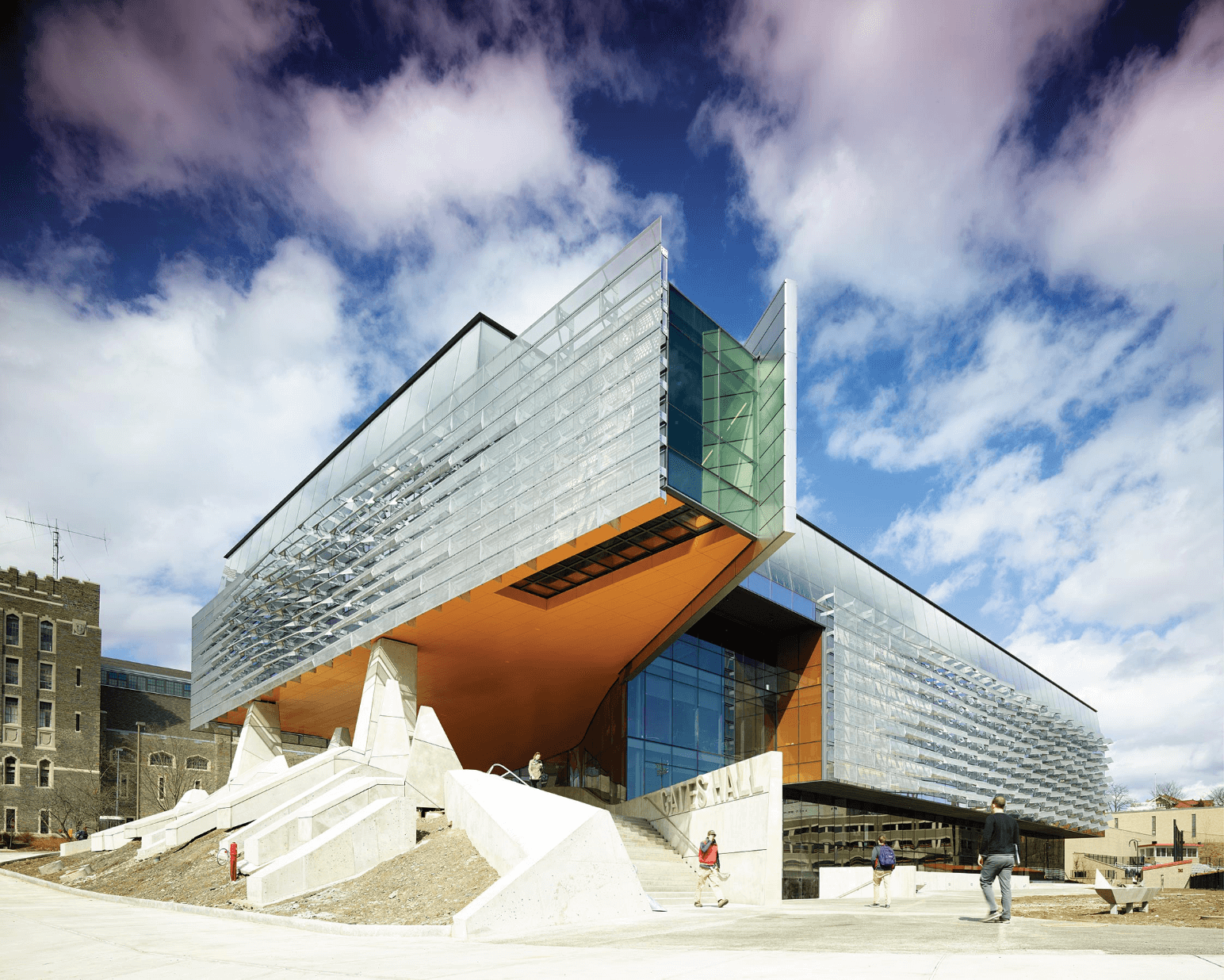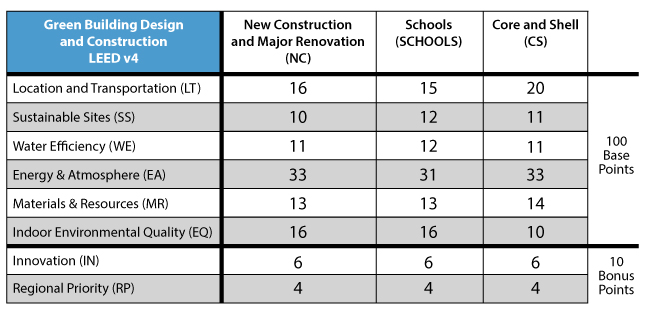Green building design is a major influence. That’s nothing new at Viracon-it’s been our focus for over 45 years. Today, you can select from hundreds of sustainable architectural glass alternatives, as well as tap into design help and technical expertise, to meet LEED® credit requirements. All without compromising aesthetics or energy efficiencies. How cool is that?
For complete information on LEED and the certification process, access the USGBC website.
Sustainable Design
Designing to meet the needs of the present without compromising the ability of future generations to meet their needs.
The U.S. Green Building Council (USGBC)
USGBC is a global movement of professionals, businesses, innovators and community leaders working to accomplish a single bold vision: healthy, efficient and equitable buildings and communities for all.
Leadership in Energy and Environmental Design (LEED®)
LEED® is a rating system for high performance sustainable buildings. It was created to define green building and raise consumer awareness of green building benefits. LEED v.4 has four levels of certification: Certified: 40-49 points, Silver: 50-59 points, Gold: 60-79 points and Platinum: 80 points and above. Before being able to receive any credits, one must first complete one of the prerequisites offered for each category. Once a prerequisite has been obtained, the project can begin earning points. A certain amount of points can be added to become a credit, which allows for a project to be labeled as LEED certified.
Within LEED v.4, there are four levels of certification:
- Certified: 40-49 points
- Silver: 50-59 points
- Gold: 60-79 points
- Platinum: 80 points and above
There are 100 base points, 6 possible Innovation and 4 Regional Priority points. The points cover the entire building process including everything from site selection all the way through building occupancy and are broken into 6 base categories and 2 bonus categories.
Out of the eight total categories, glass selection may be able to help in four; Energy and Atmosphere (EA), Materials and Resources (MR), Indoor Environmental Quality (EQ) and Innovation (IN). The following illustrates which credits glass may affect within each category.
Energy & Atmosphere (EA)
There are four options to earn a prerequisite in the Energy and Atmosphere category. A prerequisite is worth no points, however they must be done in order to achieve any LEED® certification. In addition to the prerequisite there are six credits. In the LEED® rating system a credit is not the same as a point. A credit is essentially an area of emphasis within the category, each credit has a set number of points available within it. Glass selection may be able to help with one of the three prerequisites and one of the six credits in this area.
EA Prerequisite 2: Minimum Energy Performance
Option 1 requires software energy simulation; Options 2 and 3 do not require modeling.
- Option 1- Whole Building Energy Simulation
Demonstrate a 5% improvement in the proposed building performance rating for new buildings, compared to the baseline building performance rating according to the building performance rating method in Appendix G of ANSI/ASHRAE/IESNA Standard 90.1-2010 using a computer simulation model for the whole building project. - Option 2- Prescriptive Compliance: ASHRAE 50% Advanced Energy Design Guide
This option only applies to office buildings under 100,000 square feet or retail buildings 20,000 to 100,000 square feet, large hospitals over 100,000 square feet, or K-12 School Buildings. - Option 3- Prescriptive Compliance: Advanced Buildings Core Performance Guide
This option only applies to projects less than 100,000 square feet. Healthcare, warehouse and laboratory projects are ineligible for this path.
EA Credit 1: Optimize Energy Performance, 1-18 points possible
Select one of the following three compliance paths. Option 1 requires software energy simulation; Options 2 and 3 do not require modeling. Achieving points through any of the three options assumes compliance with EA Prerequisite 2: Minimum Energy Performance.
- Option 1 – Whole Building Energy Simulation (1-18 points possible for NC)
Demonstrate a percentage improvement in the proposed building performance rating compared with the baseline building performance rating according to ANSI/ASHRAE/IESNA Standard 90.1-2007 using a computer simulation model for the whole building project. The further the Standard is exceeded the more points are achieved. - Option 2 – Prescriptive Compliance: Advanced Energy Design Guide (1-6 points)
**To be eligible for Option 2 as a credit, projects must use Option 2 in EA Prerequisite Minimum Energy Performance.
Implement and document compliance with the applicable recommendations and standards in Chapter 4, Design Strategies and Recommendations by Climate Zone, for the appropriate ASHRAE 50% Advanced Energy Design Guide and climate zone.
Glass Products for EA Prerequisite and Credit 1
Exceeding ASHRAE 90.1-2007 involves more than just selecting a glass product. First, it is necessary to decide the goal. By what percentage will the building’s efficiency need to exceed ASHRAE? This percentage improvement will help determine, typically through energy modeling, the specific glass performance requirements. Once you have these requirements, feel free to contact us to help find products that will meet your requirements. A high performance solar control coating will improve the energy consumption of a building.
Materials & Resources (MR)
There is two prerequisites along with five credits available in Materials and Resources. Glass selection may be able to help with three of the five credits in this area.
MR Credit: Building Product Disclosure and Optimization – Environmental Declaration (2 points)
To encourage the use of products and materials for which life-cycle information is available and that have environmentally, economically, and socially preferable life-cycle impacts. To reward project teams for selecting products for which the chemical ingredients in the product are inventoried using an accepted methodology and for selecting products verified to minimize the use and generation of harmful substances. To reward raw material manufacturers who produce products verified to have improved life-cycle impacts.
MR Credit: Building Product Disclosure and Optimization – Sourcing of Raw Materials (2 points)
- Option 1 – Raw Material Source and Extraction Reporting (1 Point)
Use at least 20 different permanently installed products from at least five different manufacturers that have publicly released a report from their raw material suppliers, a commitment to long-term ecologically responsible land use, as well as commitment to reducing environmental harms from extraction and/or manufacturing processes. - Option 2 – Leadership Extraction Practices (1 Point)
Use products that meet at least one of the responsible extraction criteria for at least 25%, by cost, of the total value of permanently installed building products in the project.For credit achievement, products sourced (extracted, manufactured, and purchased) must be within 100 miles of the project site. The material Viracon uses in the glass fabrication process comes from a variety of suppliers. Each supplier uses raw materials extracted from multiple locations. It is not possible, with the current fabrication systems, to track each fabricated glass unit back through these processes to a specific point of extraction. Viracon’s products will not contribute towards this credit.Float glass used in commercial applications contains recycled material, however, is excluded from being labeled as recycled. The only content meeting the definition of recycled content is glass returned to a float manufacturer from another source, such as a fabrication facility. Exact percentages vary by manufacturer and are deemed proprietary. As a result, Viracon’s glass products contain recycled content, but do not contribute to this credit per LEED® guidelines.
MR Credit: Building Product Disclosure and Optimization – Material Ingredients (2 points)
- Option 1 – Material Ingredient Reporting (1 Point)
Use at least 20 different permanently installed products from at least five different manufacturers that use any of the programs to demonstrate the chemical inventory of the product to at least 0.1% (1000ppm). - Option 2 – Material Ingredient Optimization (1 Point)
Use products that document their material ingredient optimization using the prescribed paths for at least 25%, by cost, of the total value of permanently installed building products in the project. - Option 3 – Product Manufacturer Supply Chain Optimization (1 Point)
Use products for at least 25%, by cost, of the total value of permanently installed products in the project.Viracon does not have a published Health Product Declaration with full disclosure of known hazards in compliance with the Health Product Declaration open Standard. Viracon’s products cannot contribute to this credit.
Indoor Environmental Quality (EQ)
There are two prerequisites along with nine credits available in the Indoor Environmental Quality category. Glass selection can help with one of the credits in this area.
EQ Credit: Daylight, (3 points)
Daylight 75% of regularly occupied spaces. This can be determined through one of three methods:
- Option 1 – Simulation: Spatial Daylight Autonomy and Annual Sunlight Exposure (2-3 Points)
Demonstrate through annual computer simulations that spatial daylight autonomy of at least 55% or 75% is achieved. Use regularly occupied floor area. - Option 2 – Simulation: Luminance Calculations (1-2 Points)
Demonstrate through computer simulations that illuminance will be between 300 lux and 3,000 lux for 9 a.m. and 3 p.m., both on a clear-sky day at the equinox, for the floor area indicated. Use regularly occupied floor area. - Option 3 – Measurement (2-3 Points)
Achieve luminance levels between 300 lux and 3,000 lux for a minimum of 75% or 90% of regularly occupied floor area.
EQ Credit: Quality Views (1 point)
Achieve a direct line of sight to the outdoors via vision glazing for 75% of all regularly occupied floor area. View glazing in the contributing area must provide a clear image of the exterior, not obstructed by frits, fibers, patterned glazing, or added tints that distort color balance.
Incorporating Viracon’s glass products into a design that meets the above requirements can contribute to the point for this credit. The Visible Light Transmittance (aka VLT or Tvis) needed to determine compliance can be found using our Product Search.
For Schools, daylight 75% of the classrooms for 1 point, 90% for two points and 75% of all other regularly occupied spaces for 1 additional point.
Daylighting is best achieved through an integrated design approach. Computer simulation can provide valuable input by showing the combined effects of multiple windows within a daylit space. The visible light transmittance of the glazing should be taken into consideration.
Using clear glass may not be the best solution, daylighting is about selecting the right amount of light, not the most light possible. When too much light is introduced glare becomes a concern. The USGBC offers the following list of common strategies to control glare; fixed exterior shading devices, exterior light shelves, interior light shelves, interior blinds and louvers, operable draperies and blinds, fritted glazing and electronic blackout glazing.
Note: Adding large spans of glass can increase the risk of birds flying into the glass. In areas where this is a concern treat the window glazing through the use of exterior shading devices or introduce patterns on the glass, such as a ceramic frit silk-screen pattern to help reduce the risk.
Innovation (IN)
There are a total of three options to achieve a maximum of five points. Project teams can use any combination of innovation, pilot, and exemplary performance strategies.
- Option 1 – This specific option designed by LEED is irrelevant for glass use, therefore Viracon will not be able to assist in this credit.
- Option 2 – Pilot (1 Point)
Achieve one pilot credit from USGBC’s LEED Pilot Credit Library.
This point may be achieved by specifically addressing the USGBC’s LEED pilot credit Bird Collision Deterrence. - Building Façade Requirements
Develop a building façade to make the building visible, eliminating conditions that create confusing reflections to birds. If all materials on the building façade have a Threat Factor of 15 or below, the project is exempt from the building façade requirements.Viracon has submitted specific glass make-ups with ceramic frit silkscreened patterns to the American Bird Conservancy (ABC) for testing their effectiveness in reducing bird collisions with favorable results. Viracon products that incorporate a ceramic frit may contribute towards this credit.


